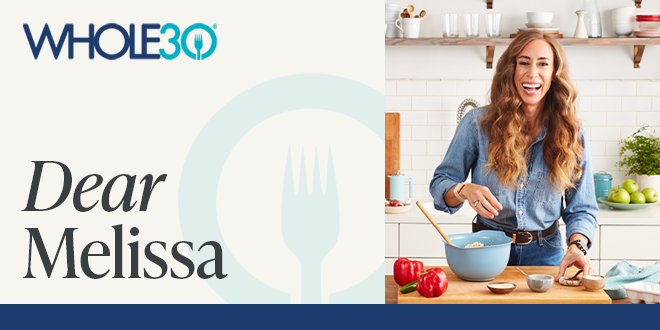Dear Melissa,
I know you’re supposed to reintroduce on the Whole30, but I still struggle with this phase. Why does 10 days of reintroduction feel even harder than 30 days of elimination? Love, Everyone
Dear Everyone,
I GET IT. I’ve heard for years that reintroduction feels so difficult or nerve-wracking that you’re tempted to just skip it altogether. In fact, this is a big reason why I wanted to write The New Whole30, and create our new Whole30 Foundations course! In both of these resources, I wanted to offer mindset shifts and practical tips to help you succeed with reintroduction and your food freedom.
Here are three reasons why your Whole30 reintroduction (Original or Plant-Based) feels so hard, and steps you can take to immediately improve your Whole30 results.
Reason 1: You don’t think of reintroduction as part of the Whole30
When I started putting Whole30 resources together in 2009, I spent all of my time focused on helping you through 30 days of no added sugar, alcohol, grains, legumes, or dairy. The 30 days of elimination are challenging, and often represents a huge change to your everyday diet. You needed shopping lists, meal templates, travel guides, pantry-stocking guides, emergency food ideas… those 30 days require a ton of guidance, support, and resources.
I assumed you’d recognize how important reintroduction was to your Whole30 results. Reintroduction is the fun part, where you get to add foods back in. And reintroduction is where you identify the foods that may have been contributing negatively to your symptoms.
However, I soon realized many of you were skipping a proper reintroduction—or any reintroduction at all. As a result, when I was writing The New Whole30, I knew I’d have to talk about reintroduction in a whole new way. In the book, I purposefully describe reintroduction as the second half of the Whole30 from the very first page. It’s one of the biggest mindset shifts you’ll find in the book, and I know it will make a huge difference to your Whole30 results. The New Whole30 will help you realize you’re not done with the Whole30 until you’ve finished a structured, systematic reintroduction.
I know it’s called the Whole30. I wish “the Whole40 or maybe 45” rolled off the tongue better, but that is how you have to think about it. You’re not done with the Whole30 until you’ve finished reintroduction, and then (using my follow-up book Food Freedom Forever) take what you’ve learned in both phases to craft your perfect, sustainable Food Freedom plan.
THE FIX: Using The New Whole30 as your guide, start thinking about your Whole30 as elimination and reintroduction. Treat each phase with the same diligence and commitment. Build reintroduction into your calendar. Don’t plan a major celebration, vacation, or athletic event until those 10+ days are over. Cross off your reintroduction days just as you did the first 30. Your Whole30 isn’t over until reintroduction is over.
Reason 2: You don’t understand the importance of reintroduction
Our new Whole30 Foundations course does a fantastic job of explaining the importance of the elimination phase and the reintroduction phase. Magical things can happen to your body and brain in the absence of these potentially problematic foods. Will your digestion improve, will your skin clear up, will you have more energy, fewer cravings, better sleep, less pain? The elimination period is exciting. The results can show up fast, and feel highly motivating. At the end of elimination, you may feel so good, you can’t imagine going back to your old habits. If that’s how you feel, do you really need to reintroduce?
Yes, you do. Especially if this is how you feel. You know you feel better when you don’t eat any of these food groups. That is wonderful news! But you still miss some of the foods you used to eat, and really want to bring them back in a way that still keeps you feeling your best. To do that, you’ll need to know which foods, specifically, were contributing to your skin conditions, digestive issues, energy dips, cravings, sleep disturbances, and pain or fatigue. You discover that half of the equation in reintroduction.
I explain the importance of reintroduction in a clear, concise way in Whole30 Foundations, starting on Day 24. In fact, there are 16 videos on reintroduction alone in the course! Most importantly, I’ll tell you exactly why you need reintroduction to achieve lasting food freedom. To get the full picture of just how important reintroduction is to your Whole30 results and Food Freedom plan, you can also read or listen to the reintroduction chapters and FAQ in The New Whole30
THE FIX: Recognize that reintroduction is where you get the second half of your Whole30 learnings. Using the support, guidance, and worksheets you’ll find in the Whole30 Foundations course, make a plan for maximizing your Whole30 results in the reintroduction phase. Take good notes, start drafting your reintroduction food groups and meals, and achieve the Whole30 results you’ve been dreaming of!
Reason 3: You’re nervous about reintroducing
For many, the 30-day elimination period of the Whole30 feels like freedom, even if you’re missing some of your favorite foods. During elimination, decisions are pretty black-and-white: Is there sugar in the ingredients? Is there dairy in the dressing? There’s no debating with yourself, no negotiations. The answers are simply “yes, this fits” or “no, this isn’t compatible.” This can feel vastly reassuring, like a safe little cocoon.
In addition, elimination can make you feel so good, you’re nervous to mess with it. If you came to the program with unrelenting cravings, chronic pain or fatigue, digestive distress, or energy slumps, it makes sense why you wouldn’t want to go back to that. You may see reintroduction as a threat to your current state. Some are so nervous about what reintroduction might bring that you even extend your elimination phase to avoid it.
However, the Whole30 wasn’t meant to be followed long-term; it’s a short-term elimination and reintroduction program. Avoiding reintroduction isn’t going to lead you to food freedom, either. (Many of you know this from experience.) So yes, you have to reintroduce, but you don’t have to be nervous about it!
In both The New Whole30 and Whole30 Foundations, you’ll find a detailed reintroduction plan designed to set you up for success. Even if a reintroduction group brings on negative symptoms, you’ll always return to the elimination phase for 2-3 days afterward. This allows you time to let those symptoms calm, and provides you with the structure and meals you’ll need to help you feel your best again. And if a reintroduction day brings back cravings, energy disruptions, pain, or other issues, these resources will quickly guide you back to a healthy balance. It’s right there in the plan! Just return to the elimination phase until you feel good again.
THE FIX: Reassure your brain that you do have a good reintroduction plan, and there is no reason to be nervous. Using The New Whole30 or Whole30 Foundations, create a calendar of reintroduction days and which food groups you’ll bring back on which days. Add 2-3 days of Whole30 elimination between each group. (You can also find a sample Original Whole30 schedule or Plant-Based version on our website.) Take as long as you need before reintroducing the next food group.
Bonus: Use Real Plans to quickly and easily plan your reintroduction meals too, using their proven system and hundreds of built-in Whole30 recipes.
Reintroduction success!
Succeeding with the Whole30 and extending that success into your food freedom depends on your commitment to the full process, not just the 30-day elimination period. In our new Whole30 Foundations course, you’ll also find bonus mindset shifts and tips to help you see reintroduction through in a whole new way. Stay committed, stick to your reintroduction plan, and enjoy all of the benefits the second phase of the Whole30 can bring you.
XO Melissa
Some links in this post are affiliate links, meaning we get a small commission on purchases made via our link. Thank you for supporting our Whole30 partners.















